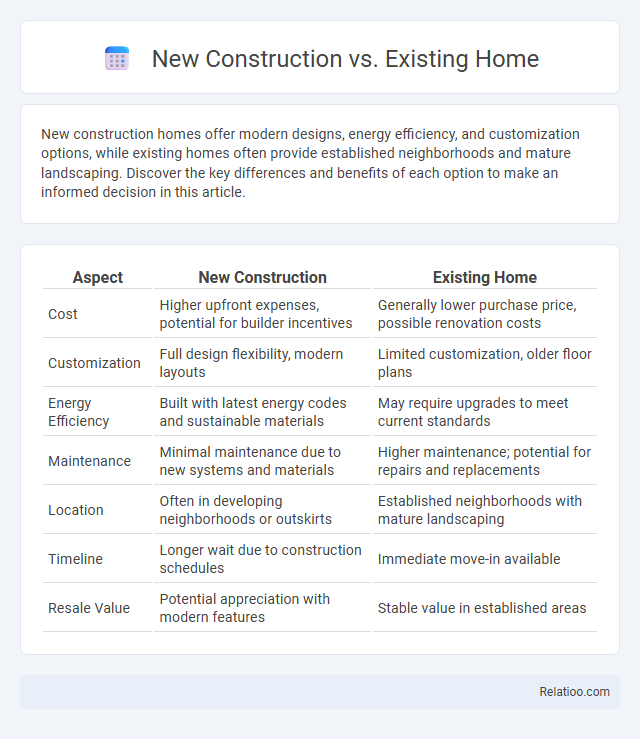New construction homes offer modern designs, energy efficiency, and customization options, while existing homes often provide established neighborhoods and mature landscaping. Discover the key differences and benefits of each option to make an informed decision in this article.
Table of Comparison
| Aspect | New Construction | Existing Home |
|---|---|---|
| Cost | Higher upfront expenses, potential for builder incentives | Generally lower purchase price, possible renovation costs |
| Customization | Full design flexibility, modern layouts | Limited customization, older floor plans |
| Energy Efficiency | Built with latest energy codes and sustainable materials | May require upgrades to meet current standards |
| Maintenance | Minimal maintenance due to new systems and materials | Higher maintenance; potential for repairs and replacements |
| Location | Often in developing neighborhoods or outskirts | Established neighborhoods with mature landscaping |
| Timeline | Longer wait due to construction schedules | Immediate move-in available |
| Resale Value | Potential appreciation with modern features | Stable value in established areas |
Introduction to New Construction vs Existing Home
New construction homes offer the advantage of modern design, energy-efficient systems, and customized features, making them appealing to buyers seeking personalization and lower maintenance costs. Existing homes often provide established neighborhoods, mature landscaping, and potentially lower purchase prices, but may require updates or renovations to meet current standards. Evaluating new construction versus existing homes involves considering factors like budget, location preferences, and long-term investment in homeownership.
Cost Comparison: New Builds vs Pre-Owned Homes
New construction homes typically have higher upfront costs due to modern materials, customization options, and energy-efficient features, while existing homes may present lower initial prices but often require additional expenses for repairs or renovations. You should weigh long-term value against immediate affordability, considering factors like property taxes, insurance, and maintenance costs. Comparing cost trends in your target market can reveal whether investing in a new build or a pre-owned home aligns better with your financial goals.
Energy Efficiency and Modern Features
New construction homes typically offer superior energy efficiency through advanced insulation, energy-efficient windows, and modern HVAC systems compared to existing homes, which often require costly upgrades to meet current standards. Modern features such as smart home technology, energy-efficient appliances, and eco-friendly materials are more commonly integrated into new builds, enhancing comfort and reducing utility bills. Homeownership of existing homes may involve balancing upfront costs with potential renovation expenses to achieve similar energy savings and feature updates.
Customization and Design Flexibility
New construction homes offer unparalleled customization and design flexibility, allowing buyers to tailor floor plans, fixtures, and finishes to their exact preferences. Existing homes often come with established layouts and design elements, limiting opportunities for major modifications without significant renovation costs. Homeownership in either scenario provides a platform to eventually personalize and upgrade the property, but new builds inherently support more seamless and cost-effective customization from the outset.
Maintenance and Repair Considerations
New construction homes typically require minimal maintenance and repairs due to newer materials and modern building standards, reducing immediate upkeep costs. Existing homes may involve more frequent repairs and updates, especially if systems like plumbing or electrical wiring are aging or outdated. Homeownership demands budgeting for ongoing maintenance expenses, with older properties often necessitating higher annual repair costs compared to newly built residences.
Location and Neighborhood Factors
Location and neighborhood factors are crucial when choosing between new construction and existing homes, as they impact your lifestyle, investment, and convenience. New construction often offers modern amenities and tailored layouts but may be situated in developing areas with evolving infrastructure, while existing homes typically provide established neighborhoods with mature landscaping, schools, and community resources. Your decision should consider proximity to work, schools, healthcare, and social amenities to ensure long-term satisfaction and property value growth.
Resale Value and Investment Potential
New construction homes often offer modern amenities and energy efficiency but may face slower appreciation compared to established neighborhoods with existing homes that have proven resale value and mature infrastructure. Existing homes typically provide stronger investment potential due to their location, historical price trends, and character that attract buyers, enhancing future marketability. Homeownership overall builds equity over time, with strategic choices between new or existing properties influencing long-term resale value and wealth accumulation potential.
Timeline and Move-In Readiness
New construction homes typically offer faster move-in readiness, often completed within months, while existing homes allow buyers immediate occupancy after closing, with timelines depending on inspection and financing. Homeownership timelines vary widely, as new builds require permit approvals and final inspections that can extend months longer than purchasing existing properties. Buyers prioritizing timeline should consider new construction's delayed move-in against existing homes' immediate availability to optimize their transition plan.
Warranty and Builder Incentives
New construction homes often come with comprehensive builder warranties covering structural defects and major systems for 10 years, providing buyers substantial post-purchase protection compared to existing homes that typically rely on limited or no warranty coverage. Builder incentives for new construction can include financial perks like closing cost assistance, upgrades, or customizable options, whereas existing homes rarely offer such benefits, making new builds financially attractive. Homeownership in newly constructed properties minimizes repair risks and maintenance expenses early on, contrasting with existing homes where unexpected repairs can impact long-term costs and investment value.
Pros and Cons: Making the Right Choice
Choosing between new construction, existing homes, and homeownership involves weighing factors like customization, cost, and maintenance. New construction offers modern design and energy efficiency but often comes at a higher price and longer wait times, while existing homes provide established neighborhoods and potentially lower costs but may require more repairs. Your decision should balance upfront expenses, long-term value, and personal preferences to find the best fit for your lifestyle and financial goals.

Infographic: New Construction vs Existing Home
 relatioo.com
relatioo.com